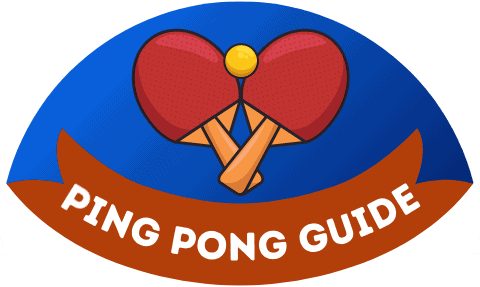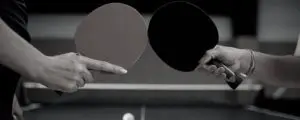Who does not know this? You buy a new bat or rubber and are happy to finally have the right grip again. In the past, I quite often bought a new paddle or rubber as soon as the old one was no longer sticky enough. In retrospect, however, that was too premature in most cases. If the paddle no longer generates the necessary spin due to the lack of grip, getting a new one should be the last option. Because there are a few tricks with which you can make the rubber sticky again. Everything I have learned and found, I share with you in this post.
How do you make the rubber sticky again? As long as the rubber is not played down, you can make it sticky again in most cases. First, you simply clean the table tennis bat with water maybe a bit of soap. Then you repeatedly apply sunflower oil to the rubber, spread it, and let it dry. Besides this lifehack, you can also use protective films and rubber boosters.
There can be different reasons why a paddle does not stick anymore. You should therefore check the reason why yours no longer has the necessary grip. In the next few lines, I will explain the best way to do this.
How to make the ping pong paddle sticky again?
1. Clean it
The very first thing you should do is clean the surface. Because the answer to why it doesn’t stick anymore may simply be that it’s dusty or dirty.
There are special cleaning sprays for this, but in most cases cleaning with water and maybe a bit of soap is enough. Simply rub the rubber carefully with both and then dry it well. Be careful not to get new fluff on the racket with the dry cloth.
Click here if you want to read more about cleaning your paddle.
Recommendation: I now exclusively use a cleaner together with a special sponge to clean my rackets. Since you only ever need 3 drops, one bottle lasts forever. The set is available for under $20:
Now you can do another test and check if the cleaning was enough. If the rubber is still not sticky enough, the cause is probably in the rubber. In that case, you should try the following…
2. The sunflower oil trick
This method is just as simple as the name sounds. You simply apply sunflower oil to the rubber and spread it well. Ideally, you use a brush for this.
It is important to let the oil dry on its own. You can repeat this several times in a row if you are still not satisfied with the results.
This trick works amazingly well. However, it should be said that the effect usually does not last that long. But you can, of course, simply perform this procedure every month and thus keep the paddle sticky for some time.
Except for the funny smell, there are no disadvantages to the rubber. But of course, there are other methods to make your racket grippy again. I should note at this point that according to ITTF it is not allowed for official competitions to treat the rubber like this.
3. Use a Booster
You can often read that you apply boosters directly to the rubber in a similar way to the oil. You could do this. However, the proper application is meant to be done by spreading the booster on the sponge, that is, on the underside of the rubber.
For this, of course, you need to peel the rubber from paddle wood and then stick it back on. It is recommended to apply 2-3 layers of the rubber tuner. Between each layer, you need to wait about 24 hours.
During this time, the rubber will curl and then flatten again. Since this method only treats the sponge and not the rubber, it should also be allowed for competition according to the manufacturer Falco.
However, I would be cautious about using it in official matches. Because the ITTF table tennis federation referred to the following rule when asked about the use of boosters:
For recreational players, boosters are still a good option, although I would try sunflower oil first before paying money for them.
4. Use protective film
You know these foils when you buy a new racket. They are also available separately to protect the bat from dirt when it is not in use. Supposedly, some of these foils give additional grip.
I can not really confirm this, but for protection, these films are very suitable.
5. Replace rubber or buy a new paddle
As said at the beginning, this should be the last option. But eventually, all the tricks will no longer work. When buying a new rubber, you can then pay special attention to its durability.
Why should a table tennis bat be sticky?
Some may wonder why a table tennis bat needs to be sticky at all. Often, you wouldn’t know it any other way than for the rubbers to be rather slippery. At least that’s how I felt for most of my childhood.
With a sticky paddle, you can give the ball extreme spin, which of course is an advantage for most shot techniques. That means your attacking balls get more topspin, your push balls get more backspin and your serves usually become more dangerous.
It is also important to know that there are different rubbers. Some are designed to generate extreme spin. If they then lose grip, the effects of the rubber become noticeably less.
If you’re used to a paddle with no grip at all, a sticky rubber can be quite a challenge at first, and you may even end up with more balls in the net.
With rubbers that are more suitable for countering spin (e.g. Anti Topspin and pimple rubbers), however, this is not such a big deal.
How to test if the paddle is still sticky enough?
If you are not quite sure whether the table tennis bat is sticky enough, before you take any further action, you can easily test it. The very first thing to check is the condition of the rubber.
If the rubber is already very worn or played down, then usually only a new rubber or racket will help. If it still looks okay, you can check the grip:
To do this, simply take a sheet of paper (make sure it’s not dusty) and press it onto the rubber. If it sticks, that’s a good sign. Now you can wave the bat through the air a bit. Ideally, the paper should stick to the rubber.
If your rubber has fallen through the test, however, there is still no reason to worry. Because you can quickly and easily regain some grip.
How does the racket stay sticky longer?
When you buy a new paddle or have just glued on new rubber, you naturally want it to remain sticky for as long as possible. Therefore, you should pay attention to the following things:
1. Use a case
Ideally, you not only use a protective film for the racket but also put it in a case or a cover. This way, it is ideally protected from dirt and other conditions.
Recommendation: A simple and solid protective cover is available for about $10.
2. Regular cleaning
I have already explained how to clean a paddle. It is best to do it regularly. This way it will keep its grip as long as possible.
3. Good quality
I can only emphasize it once again: Quality makes a big difference. Yes, you can still get a lot out of a racket with the tricks I’ve shown, but ideally, the grip just lasts very long on its own. And That way, you don’t run the risk of breaking the ITTF rules either.






